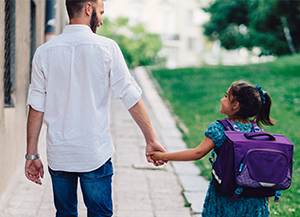We can all agree that starting anything new can be stressful. And when that happens it is helpful to feel understood and supported. We will share helpful tools that can help teachers, family members, parents, grandparents, or anyone who has a student assist the student with preparing for the nervousness or anxiety that comes from starting a new school year.
Starting a new school year can be very stressful for a student.The student is starting anew grade level that they have never experienced before.That student will have new classmates, a new teacher, and in some cases a brand-new school.
One of the first tools that can help a student with managing the back-to-school jitters is showing a student that they are understood. The power of feeling validated is extremely helpful. Knowing that others understand and acknowledge your nervousness or anxiety as something normal can bring relief to the student. This can make the student accept their feelings and be open to discussing their feelings with you. The student then will feel open to learning and accept any tips or support from you.
Some of the tips that can be shared with a student to manage the back-to-school jitters are learning positive coping skills such as taking deep breaths, meditation, yoga, listening to relaxing music, progressive muscle relaxation, going for a walk, aromatherapy, or engaging in a fun activity like a game of their choice.
Taking deep breaths can be taught to a student by telling the student to inhale slowly and exhale at a slower pace.
Meditation can be described as telling the student to close their eyes (if they feel comfortable) as they try to ignore everything that is around them and encouraging the student to focus only on their breathing.
Yoga is also a great form of relaxation that is becoming increasingly popular for students to do to relax. The student is instructed to bring their bodies into various animal poses. This allows the body to go from being tense to a state of completely relaxed as the student remains in the animal pose combined with deep breathing to release the tension in the body.
Listening to relaxing music is as simple as it sounds. The student is encouraged to listen to relaxation music of their choice. YouTube has a great selection of relaxation music to choose from.
Progressive muscle relaxation is one of the more complex positive coping skills to teach a student because in this method the student is encouraged to release the tension in their bodies by focusing on one body part at a time. The student is taught to release the tension that they are feeling in every single part of their bodies.
Going for a walk is just telling the student to go out in nature and take a walk as they focus on the nature that is around them, the plants, the sky, or other beautiful items in their surroundings.
Aromatherapy is allowing the student to relax by smelling essential oils such as lavender or eucalyptus oil. This can be done by having the student spray the lavender/eucalyptus oil, put on lavender/eucalyptus lotion on their hands, or turn on a lavender/eucalyptus candle with the intention of inhaling the lavender/eucalyptus scent to relax.
Engaging in a fun activity like a game of their choice consist of allowing the student to pick an activity of their choice to help distract their minds and become relaxed.
This article was intended to be helpful to assist others in feeling prepared to help a student who is going back-to-school manage the nervousness or anxiety that can come along with that. It is crucial that the person who is supporting a student manage the jitters that come with returning to school also practice these tools for themselves.


